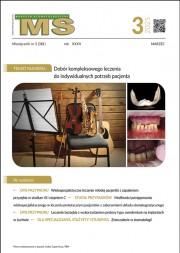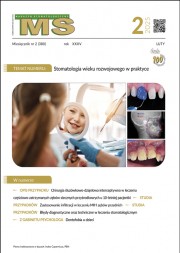Dostęp do tego artykułu jest płatny.
Zapraszamy do zakupu!
Po dokonaniu zakupu artykuł w postaci pliku PDF prześlemy bezpośrednio pod twój adres e-mail.
Współczesne metody rehabilitacji implantoprotetycznej pacjentów po resekcji kości szczęk
Contemporary methods of implantoprosthetic rehabilitation of patients after maxillectomy
Maciej Przeniosło, Anna Przeniosło, Paulina Adamska, Anna Starzyńska
Streszczenie
Leczenie chirurgiczne pacjentów z nowotworami w obrębie kości szczęk jest związane z rozległą resekcją tkanek twardych i miękkich. Prowadzi to do zaburzeń czynnościowych górnego odcinka układu pokarmowego i oddechowego oraz estetyki twarzy, a tym samym wpływa na obniżenie jakości życia pacjentów i utratę ról społecznych. Współczesna chirurgia rekonstrukcyjna wiąże się z odtworzeniem tkanek za pomocą przeszczepów i zabiegów mikrochirurgicznych. Rozwój wiedzy i metod z zakresu implantologii pozwala na wdrożenie sprawdzonych protokołów do leczenia z zakresu protetyki szczękowo-twarzowej u pacjentów po zabiegach maksylektomii. Zastosowanie implantów zygomatycznych stało się standardową procedurą wykonywaną u chorych po zabiegach częściowej resekcji szczęki. Implanty zygomatyczne są wykorzystywane
jako oparcie dla stałych i zdejmowalnych rekonstrukcji protetycznych. W przypadku chorych po zabiegach całkowitej resekcji szczęki do metod zaopatrzenia protetycznego mogą zostać wykorzystane nowoczesne techniki planowania cyfrowego i druku trójwymiarowego. Zastosowanie nowych biozgodnych materiałów wraz z jednoczesnym znacznym spadkiem kosztów wytwarzania umożliwia wdrożenie nowoczesnych rozwiązań do standardowego postępowania rekonstrukcyjnego oraz protetyki szczękowo-twarzowej. W przypadkach rozległej utraty tkanek, gdy nie ma możliwości wykonania rekonstrukcji chirurgicznej, z wyboru leczenie opiera się na zastosowaniu obturatorów i epitez twarzy. Są to uzupełnienia, które umożliwiają odtworzenie granicy pomiędzy układem oddechowym i pokarmowym, zapewniają względnie prawidłowe podparcie tkanek miękkich i powłok twarzy oraz umożliwiają pacjentowi kontrolę pod względem ewentualnej wznowy miejscowej. Celem pracy było omówienie najnowszych doniesień dotyczących możliwości leczenia implantoprotetycznego pacjentów po zabiegach resekcji kości szczęk.
Abstract
Surgical treatment of patients with jaw bone tumours is associated with extensive resection of hard and soft tissues. The functions of the upper digestive and respiratory systems are disturbed, which affects the quality of life of patients and the loss of social roles. Contemporary restorative surgery involves the reconstruction of tissues using bone grafts and microsurgical procedures. The development of knowledge and treatment methods in the field of implantology allows the implementation of proven protocols for treatment in the field of maxillofacial prosthetics in patients after maxillectomy procedures. The use of zygomatic implants has become a standard procedure performed in patients after partial resection of the maxilla. Zygomatic implants are used as a support for permanent and removable prosthetic reconstructions. In the case of patients after total jaw resection procedures, modern techniques of digital planning and 3D printing can be used for prosthetic supply methods. The use of new biocompatible materials together with a significant decrease in manufacturing costs enables the implementation of modern solutions for standard reconstructive procedures and maxillofacial prosthetics. In cases of extensive tissue loss, treatment of choice is based on the use of obturators and facial epitheses. These are restorations that enable the reconstruction of the border between the respiratory and digestive systems, provide relatively proper support for soft tissues and facial integuments, and allow the patient to be monitored for possible local recurrence. The aim of the study was to discuss the latest reports on the possibility of implantoprosthetic treatment of patients after jawbone resections.
Hasła indeksowe: implant, maksylektomia, rehabilitacja protetyczna, nowotwory jamy ustnej
Key words: implant, maxillectomy, prosthetic rehabilitation, oral cavity carcinoma
Piśmiennictwo
- Ferrari M, Taboni S, Carobbio ALC i wsp. Sinonasal squamous cell carcinoma, a narrative reappraisal of the current evidence. Cancers (Basel). 2021;13(11): 2835.
- Haerle SK, Gullane PJ, Witterick IJ i wsp. Sinonasal carcinomas. Epidemiology, pathology, and management. Neurosurg Clin N Am. 2013; 24(1): 39-49.
- Alonso JE, Han AY, Kuan EC i wsp. Epidemiology and survival outcomes of sinonasal verrucous carcinoma in the United States. 2018; 128(3): 651-656.
- Kawecki A, Nawrocki S. (red.). Nowotwory nabłonkowe narządów głowy i szyi. Online: http://www.onkologia.zalecenia.med.pl/pdf/PTOK_2013_01_Nowotwory%20nablonkowe%20glowy%20i%20szyi.pdf [dostęp: 15.11.2022].
- Lydiatt WM, Patel SG, O’Sullivan B i wsp. Head and neck cancers – major changes in the American Joint Committee on cancer eighth edition cancer staging manual. CA Cancer J Clin. 2017; 67(2): 122-137.
- Salvatori P, Paradisi S, Calabrese L i wsp. Patients’ survival after free flap reconstructive surgery of head and neck squamous cell carcinoma. A retrospective multicentre study. Acta Otorhinolaryngol Ital. 2014; 34(2): 99-104.
- Salvatori P, Mincione A, Rizzi L i wsp. Maxillary resection for cancer, zygomatic implants insertion, and palatal repair as single-stage procedure. Report of three cases. Maxillofac Plast Reconstr Surg. 2017; 39(1):
- Seok H, Kim MK, Kim SG. Reconstruction of partial maxillectomy defect with a buccal fat pad flap and application of 4-hexylresorcinol. A case report. J Korean Assoc Oral Maxillofac Surg. 2016; 42(6): 370-374.
- Kahnberg KE, Henry PJ, Hirsch JM i wsp. Clinical evaluation of the zygoma implant. 3-year follow-up at 16 clinics. J Oral Maxillofac Surg. 2007; 65(10): 2033-2038.
- Brånemark PI. Surgery and fixture installation. Zygomaticus fixture clinical procedures. Göteborg: Nobel Biocare;
- Parel SM, Brånemark PI, Ohrnell LO i wsp. Remote implant anchorage for the rehabilitation of maxillary defects. J Prosthet Dent. 2001; 86(4): 377-381.
- Hackett S, El‐Wazani B, Butterworth C. Zygomatic implant‐based rehabilitation for patients with maxillary and mid‐facial oncology defects. A review. Oral Dis. 2021; 27(1): 27-41.
- Boyes‐Varley JG, Howes DG, Davidge‐Pitts KD i wsp. A protocol for maxillary reconstruction following oncology resection using zygomatic implants. Int J Prosthodont. 2007; 20(5): 521-531.
- Butterworth CJ. Primary vs secondary zygomatic implant placement in patients with head and neck cancer – a 10‐year prospective study. Head Neck. 2019; 41(6): 1687-1695.
- Weiss CM, Reynolds T. A collective conference on the utilization of subperiosteal implants in implant dentistry. J Oral Implantol. 2000; 26(2): 127-128.
- Linkow LI. Use of a tripodal mandibular subperiosteal implant with ramus hinges for facial asymmetry. J Oral Implantol. 2000; 26(2): 120-123.
- Mangano C, Bianchi A, Mangano FG i wsp. Custom-made 3D printed subperiosteal titanium implants for the prosthetic restoration of the atrophic posterior mandible of elderly patients. A case series. 3D Print Med. 2020; 6(1):
- Garrido-Martínez P, Quispe-López N, Montesdeoca-García N i wsp. Maxillary reconstruction with subperiosteal implants in a cancer patient. A one-year follow-up. Clin Exp Dent. 2022; 14(3): e293-e297.
- Urken ML, Buchbinder D, Costantino PD i wsp. Oromandibular reconstruction using microvascular composite flaps. Report of 210 cases. Arch Otolaryngol Head Neck Surg. 1998; 124(1): 46-55.
- Allen RJ Jr, Shenaq DS, Rosen EB i wsp. Immediate dental implantation in oncologic jaw reconstruction. Workflow optimization to decrease time to full dental rehabilitation. Plast Reconstr Surg Glob Open. 2019; 7(1):
- Runyan CM, Sharma V, Staffenberg DA i wsp. Jaw in a day. State of the art in maxillary reconstruction. J Craniofac Surg. 2016; 27(8): 2101-2104.
- Ch’ng S, Skoracki RJ, Selber JC i wsp. Osseointegrated implant-based dental rehabilitation in head and neck reconstruction patients. Head Neck. 2016; 38(Suppl 1): E321-E327.
- Gürlek A, Miller MJ, Jacob RF i wsp. Functional results of dental restoration with osseointegrated implants after mandible reconstruction. Plast Reconstr Surg. 1998; 101(3): 650-655.
- Landes CA, Paffrath C, Koehler C i wsp. Zygoma implants for midfacial prosthetic rehabilitation using telescopes. 9‐year follow‐up. Int J Prosthodont. 2009; 22(1): 20-32.
- Schmidt BL, Pogrel MA, Young CW i wsp. Reconstruction of extensive maxillary defects using zygomaticus implants. J Oral Maxillofac Surg. 2004; 62(9 Suppl 2): 82-89.
- Matraszek H, Stodolak E, Błażewicz S. Protezy twarzy – aspekty medyczne i technologiczne. Engineering of Biomaterials. 2007; 10(69-72): 118-121.
- Irish J, Sandhu N, Simpson C i wsp. Quality of life in patients with maxillectomy prostheses. Head Neck. 2009; 31(6): 813-821.
- Rieger JM, Wolfaardt JF, Jha N i wsp. Maxillary obturators. The relationship between patient satisfaction and speech outcome. Head Neck. 2003; 25(11): 895-903.
- Ozaki H, Sakurai H, Yoshida Y i wsp. Oral rehabilitation of oral cancer patients using zygomatic implant-supported maxillary prostheses with magnetic attachment. Three case reports. Case Rep Dent. 2018; 2018:
- Savabi O, Nejatidanesh F, Yordshahian F. Retention of implant-supported overdenture with bar/clip and stud attachment designs. J Oral Implantol. 2013; 39(2): 140-147.















